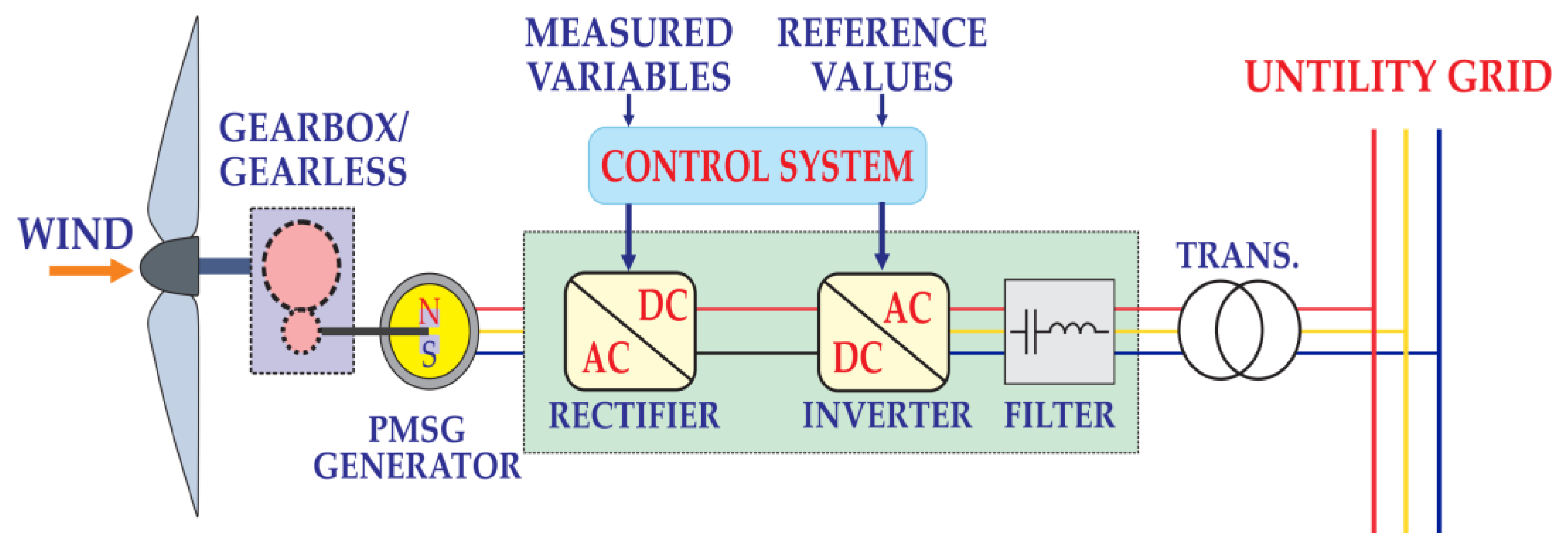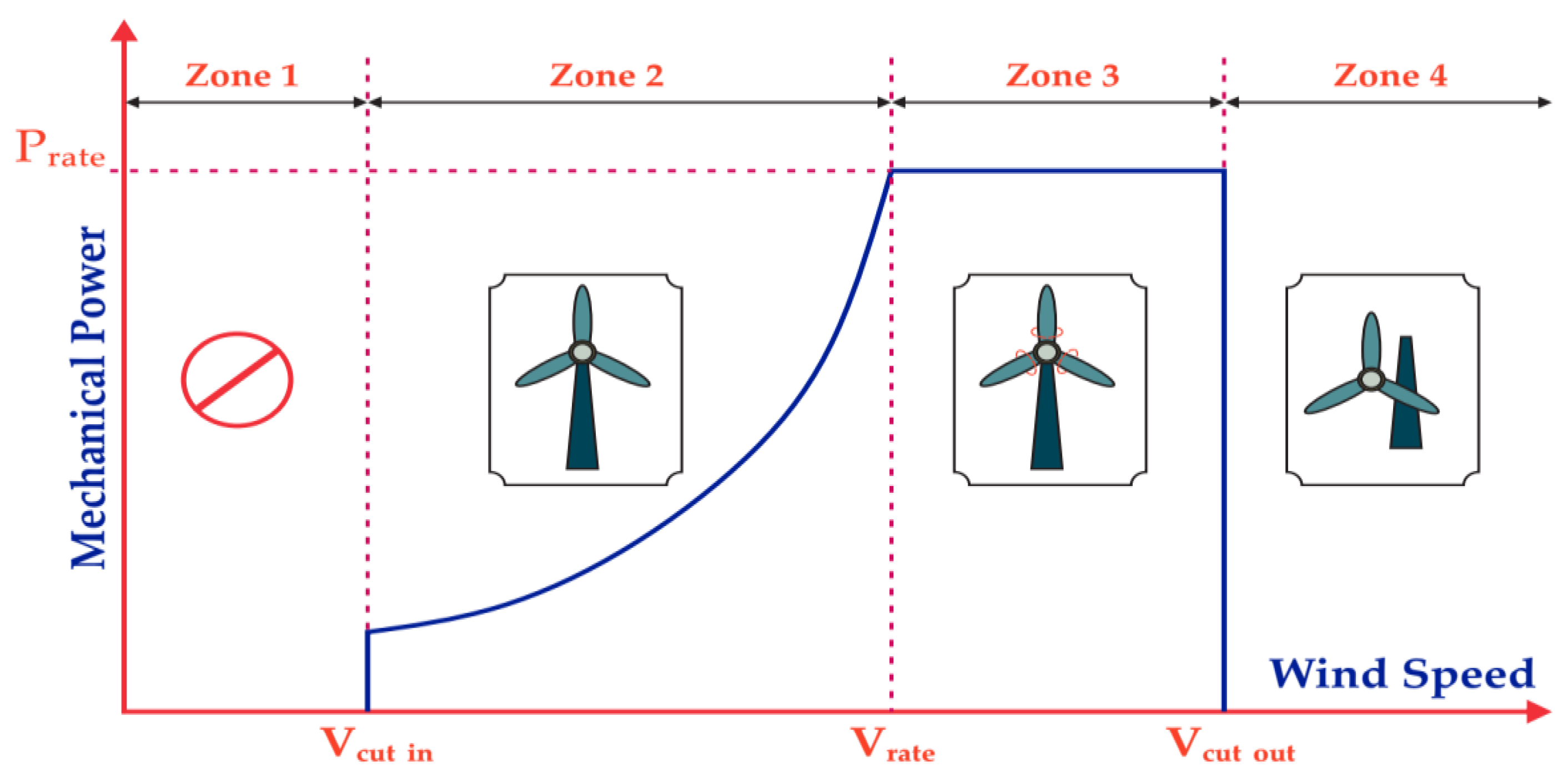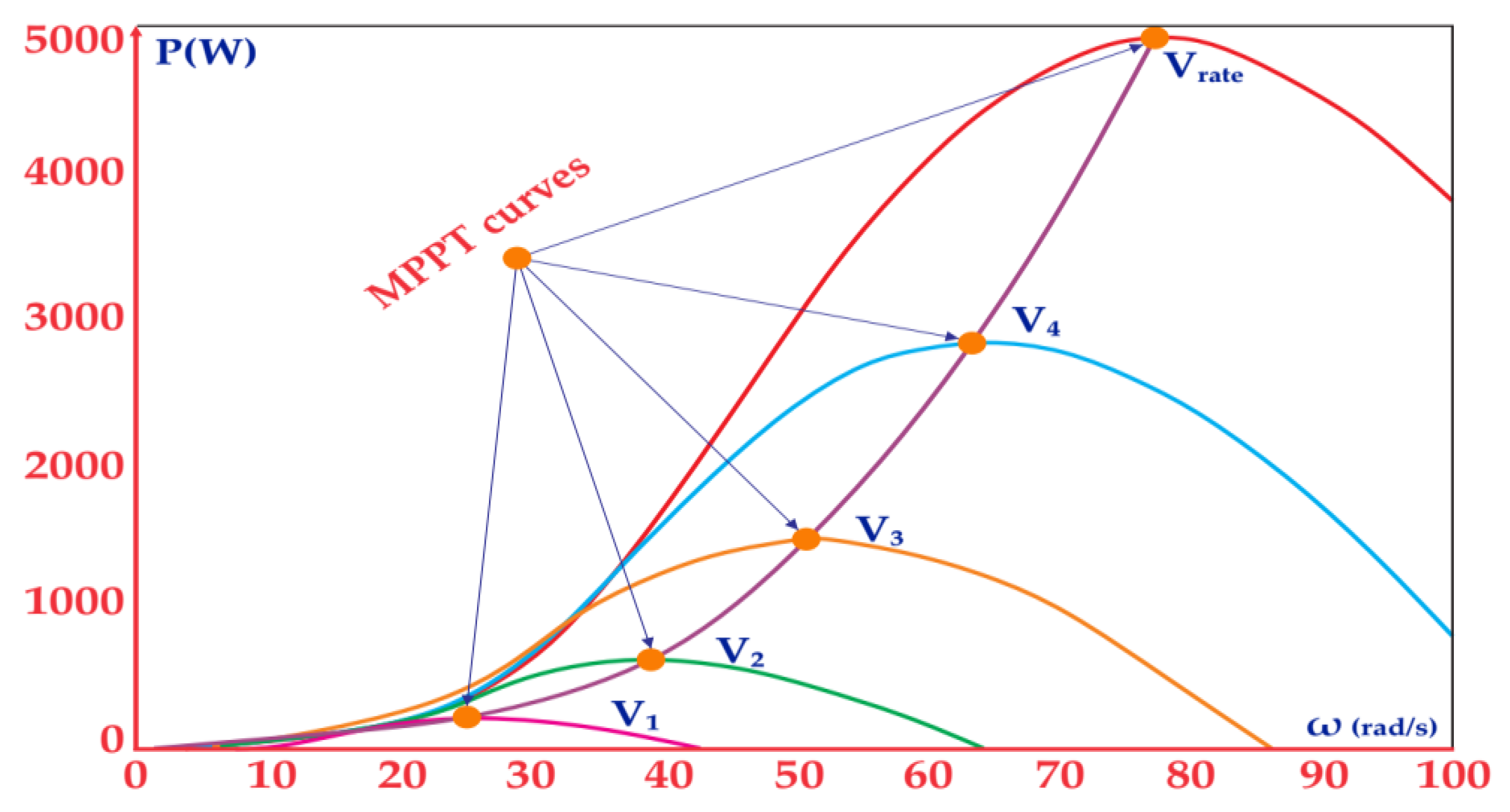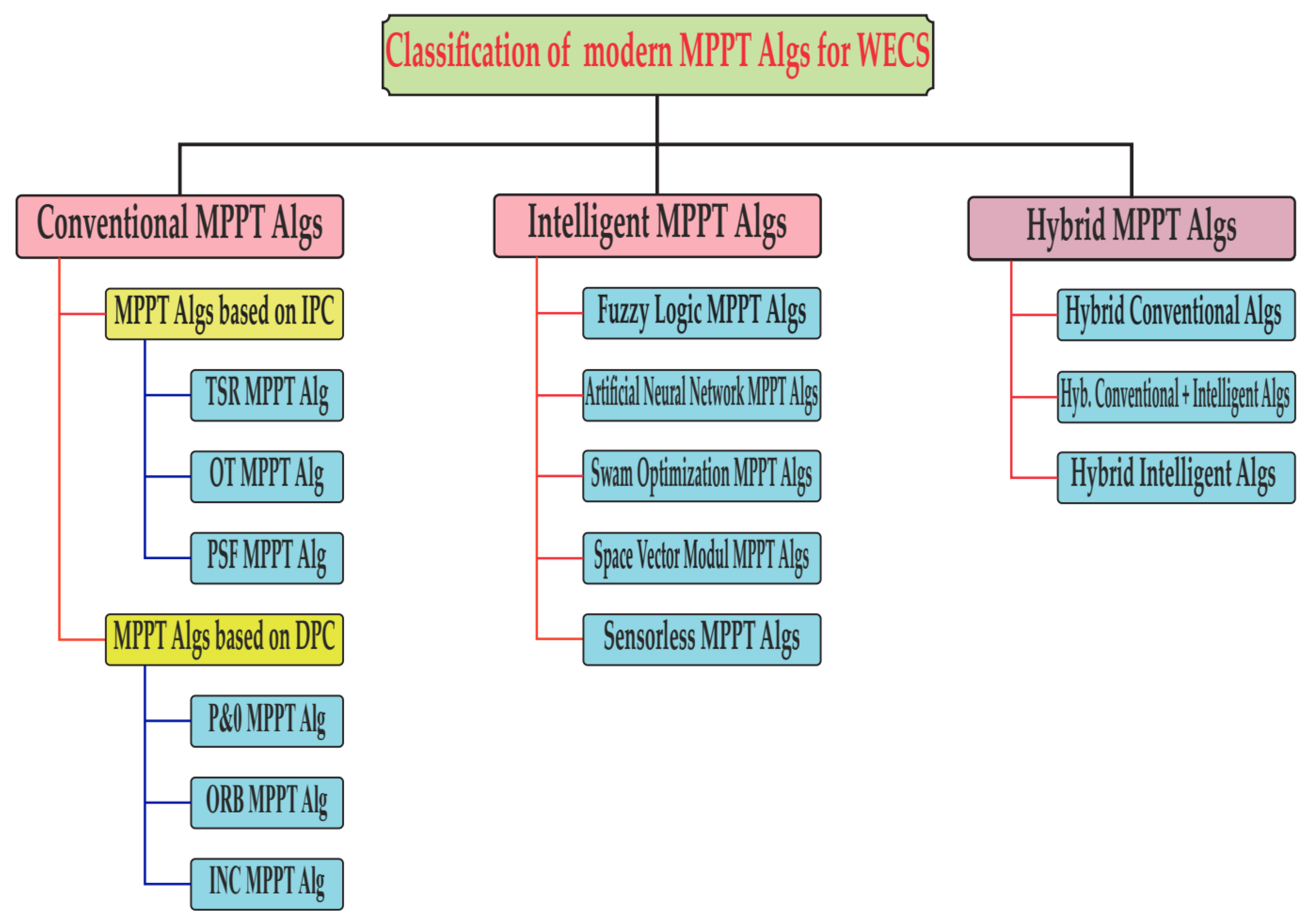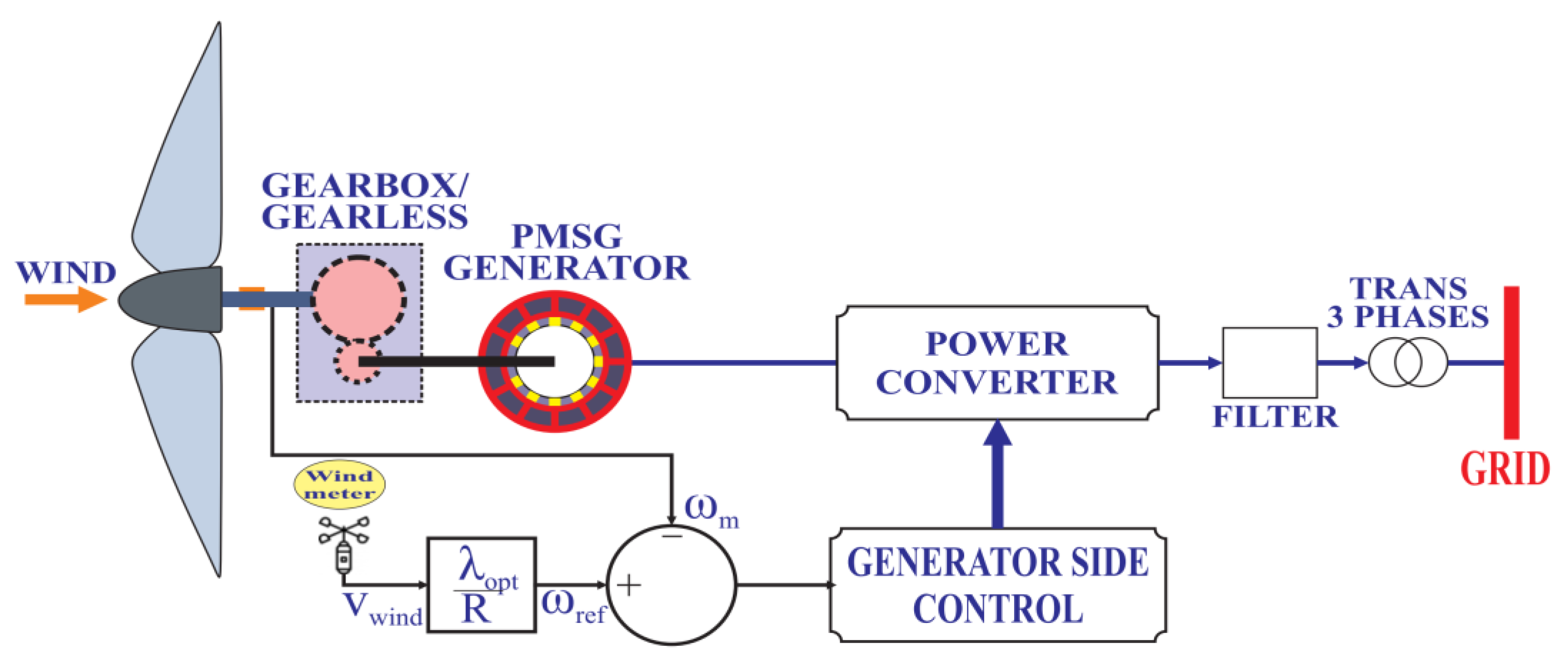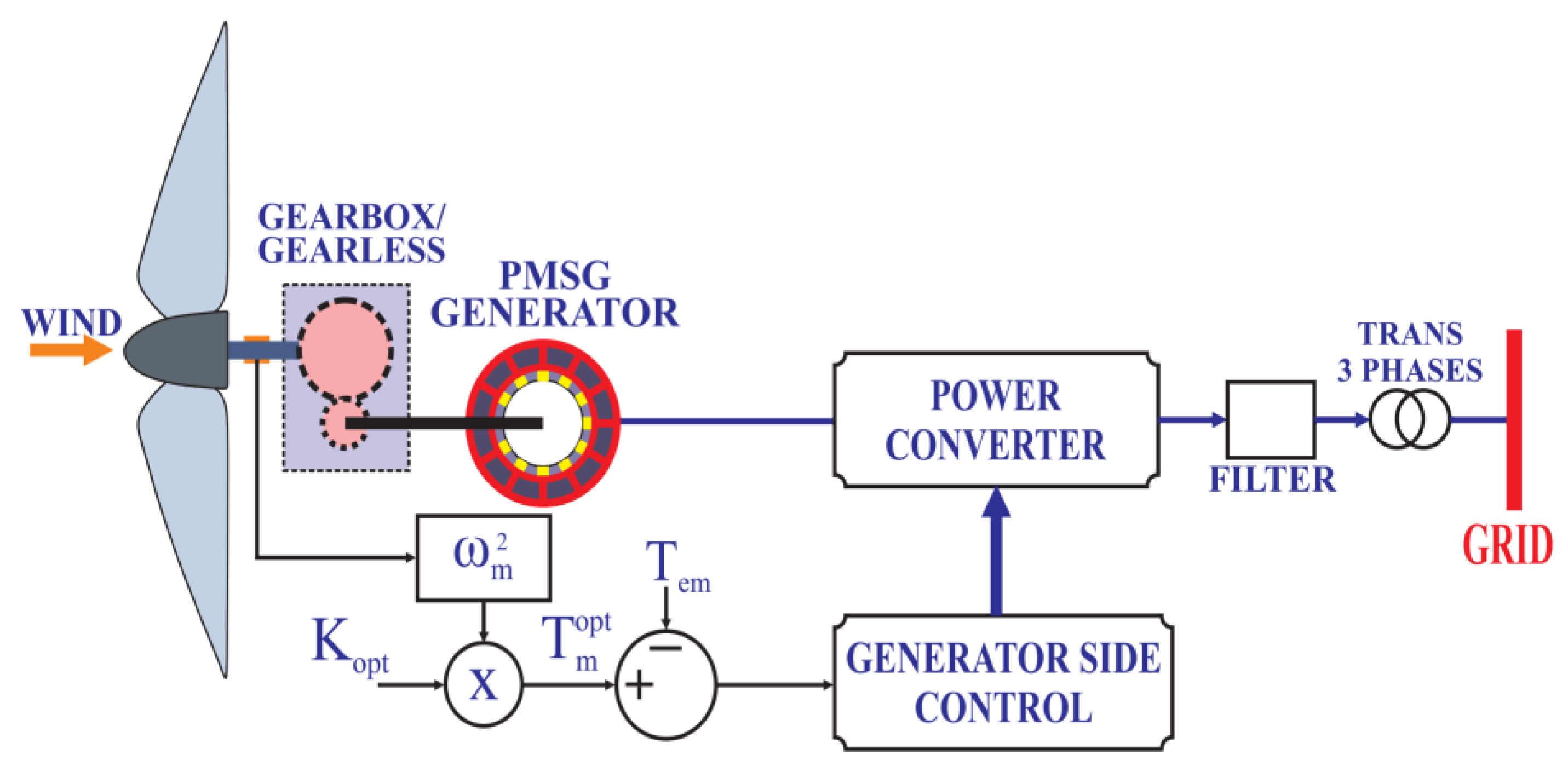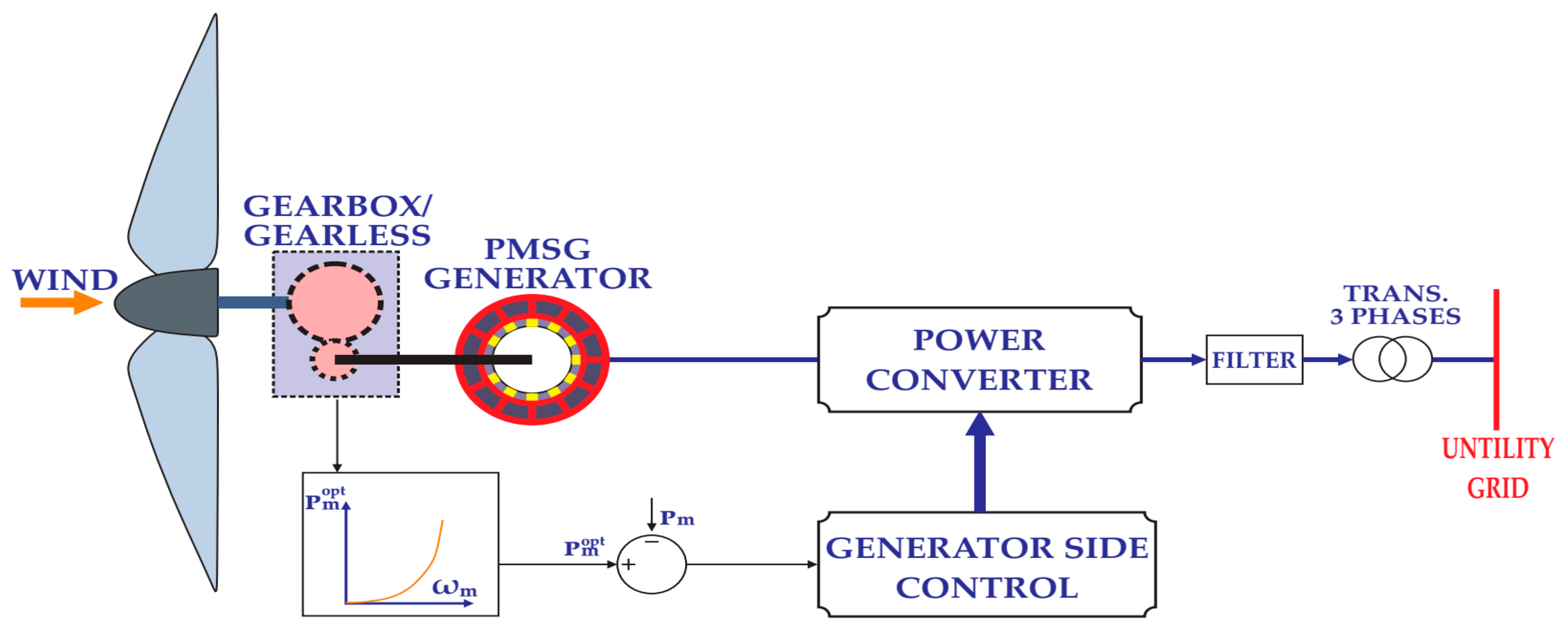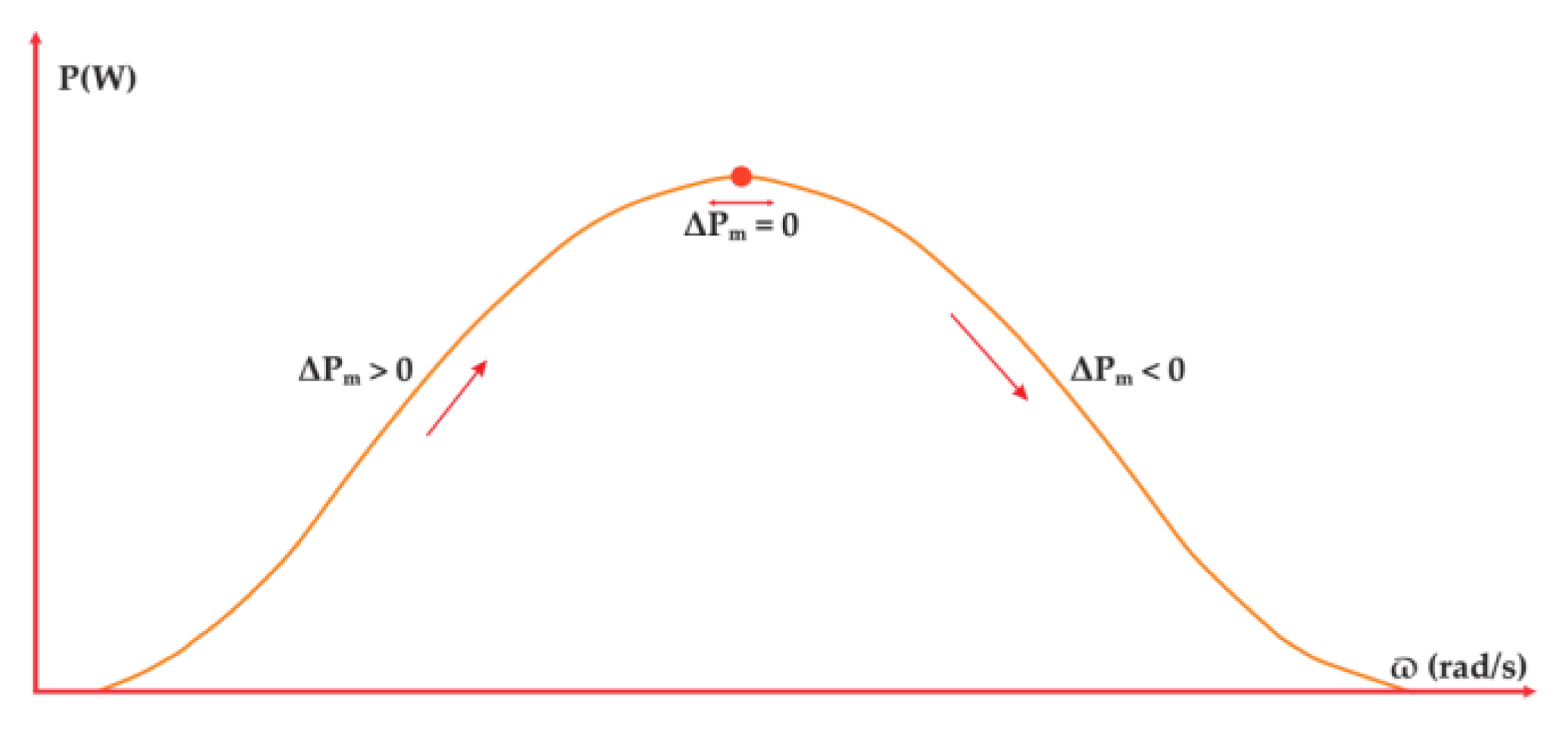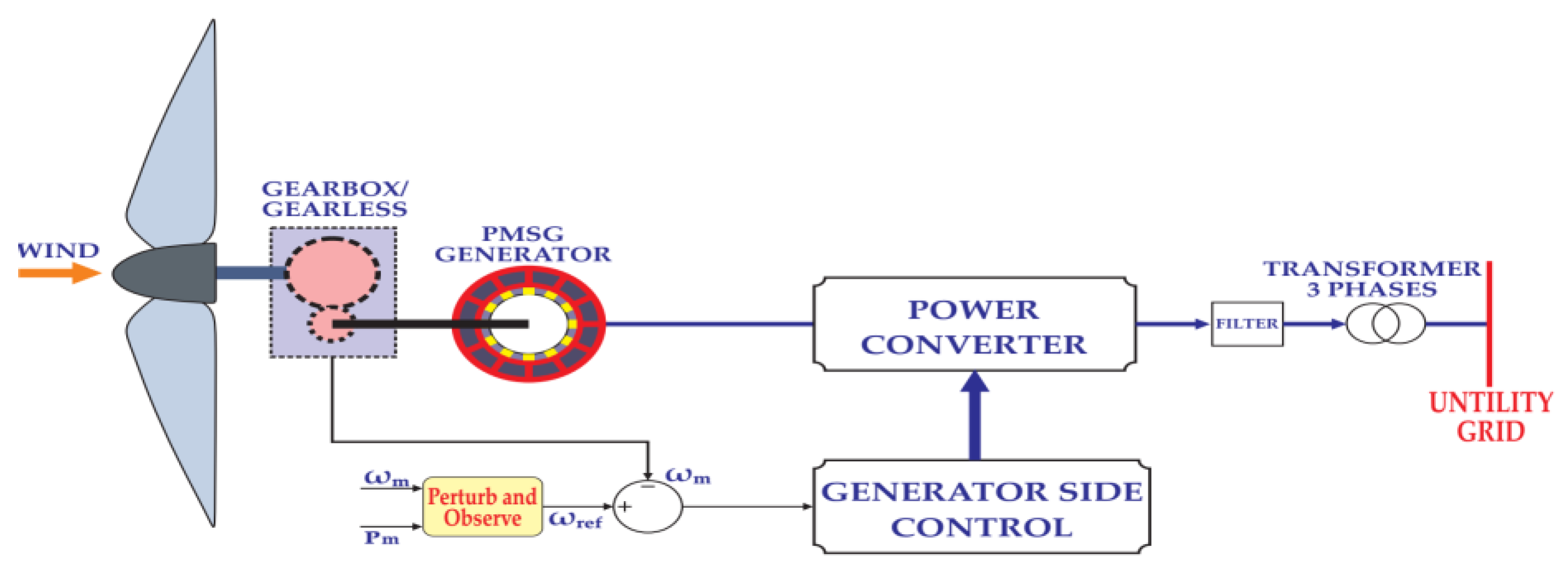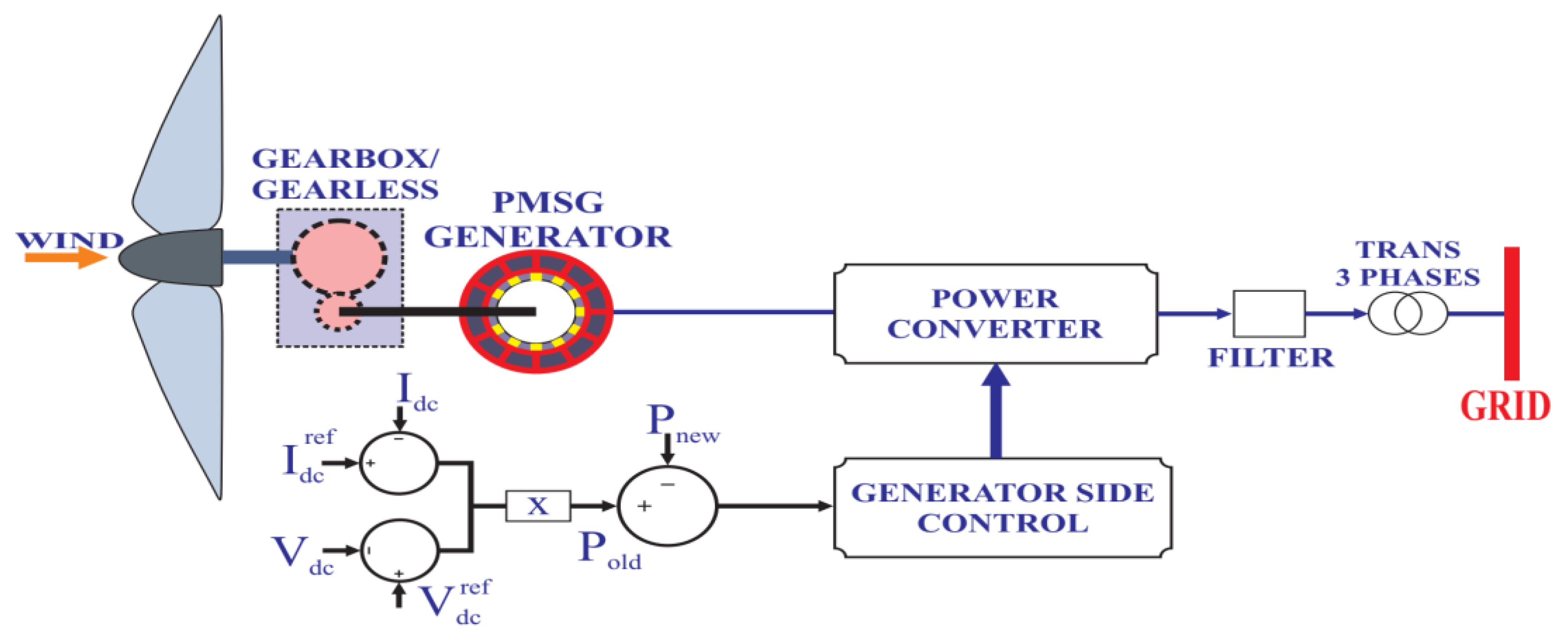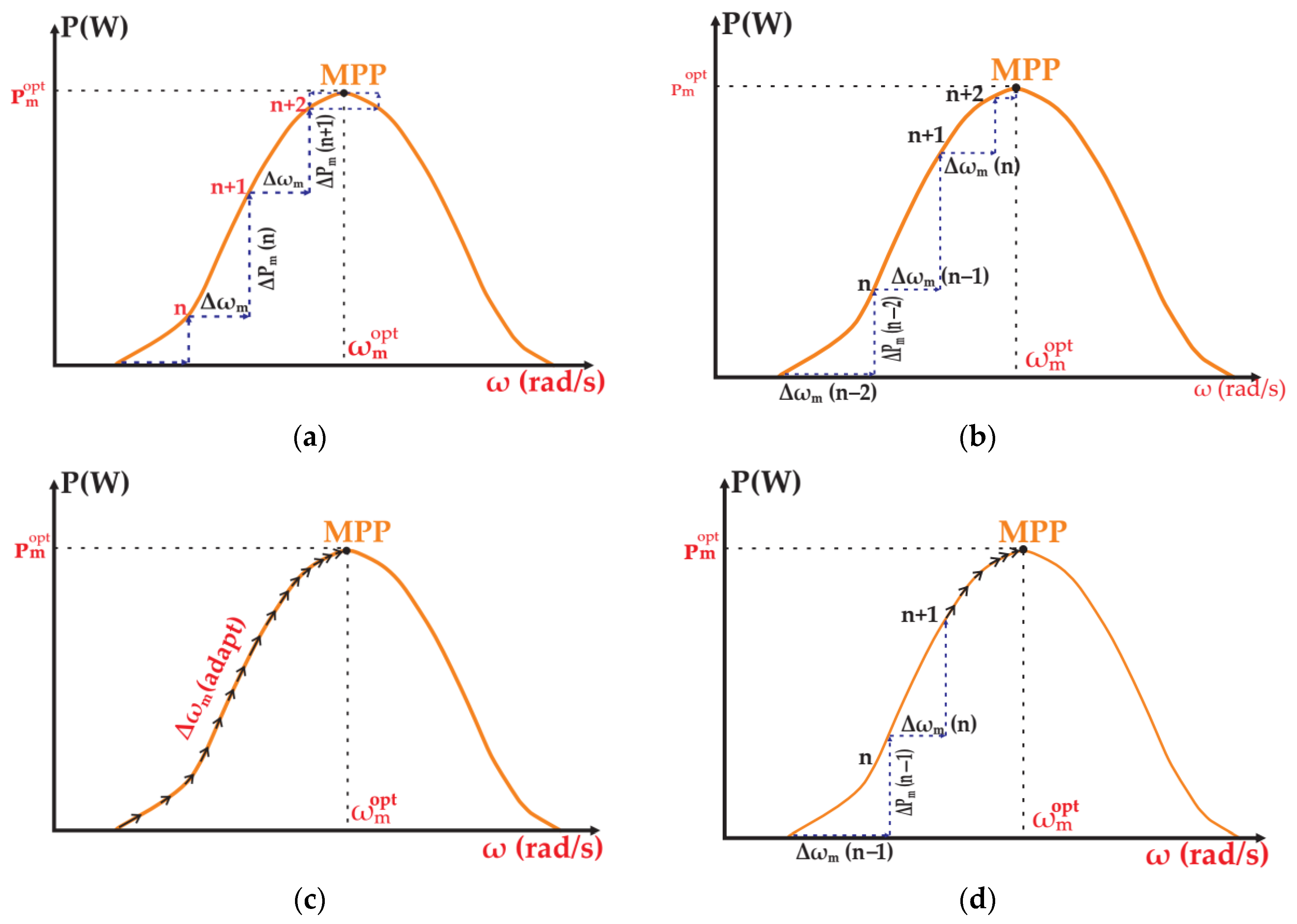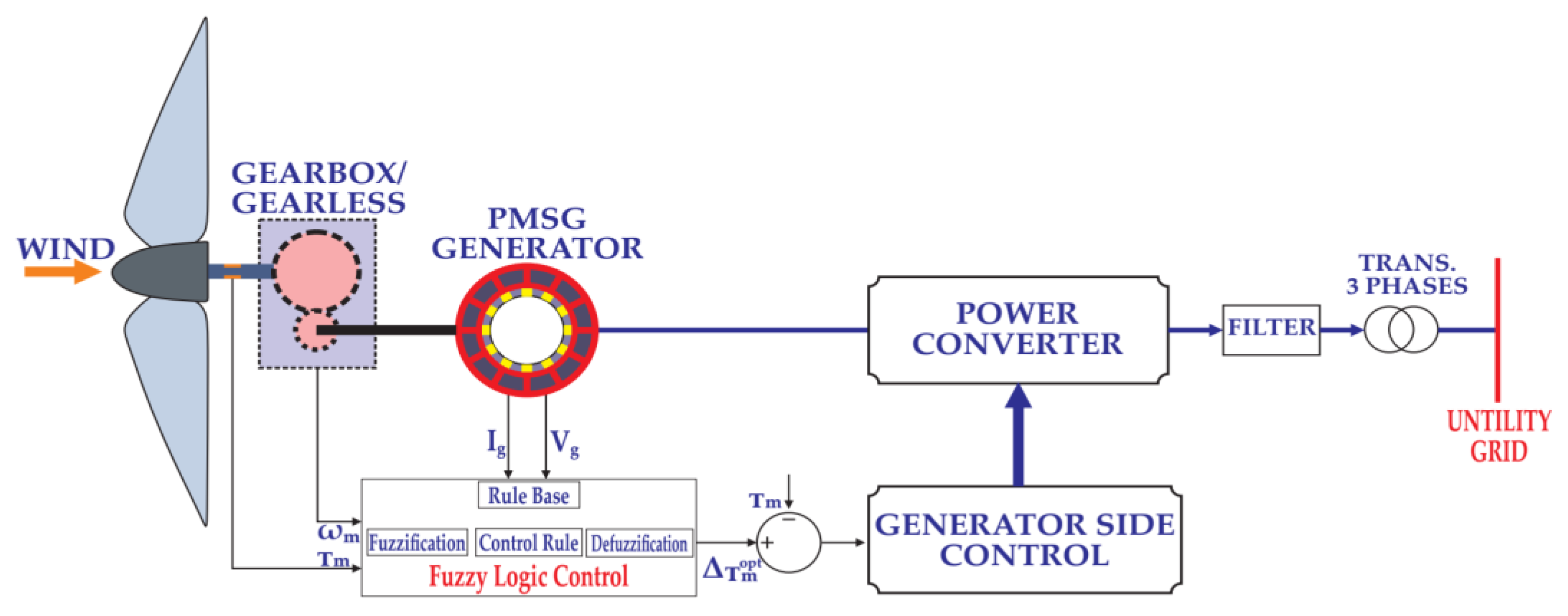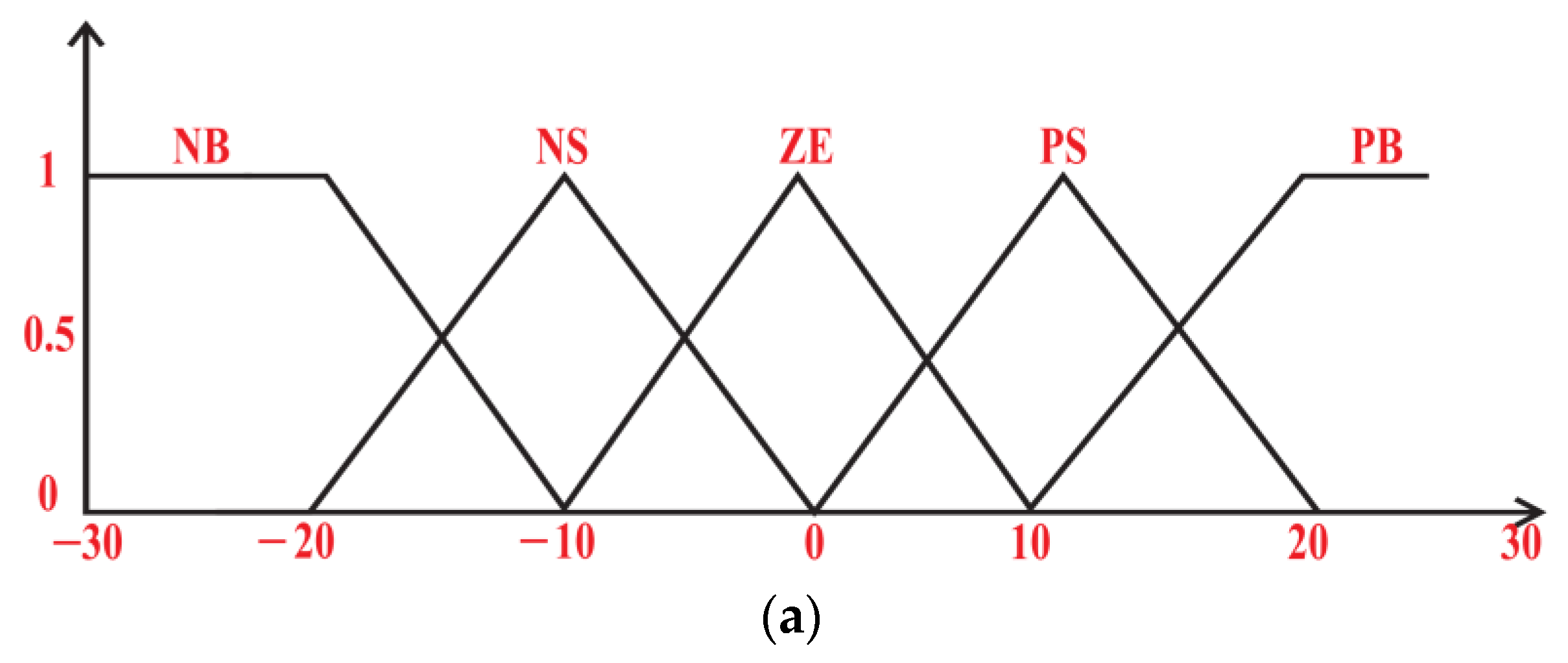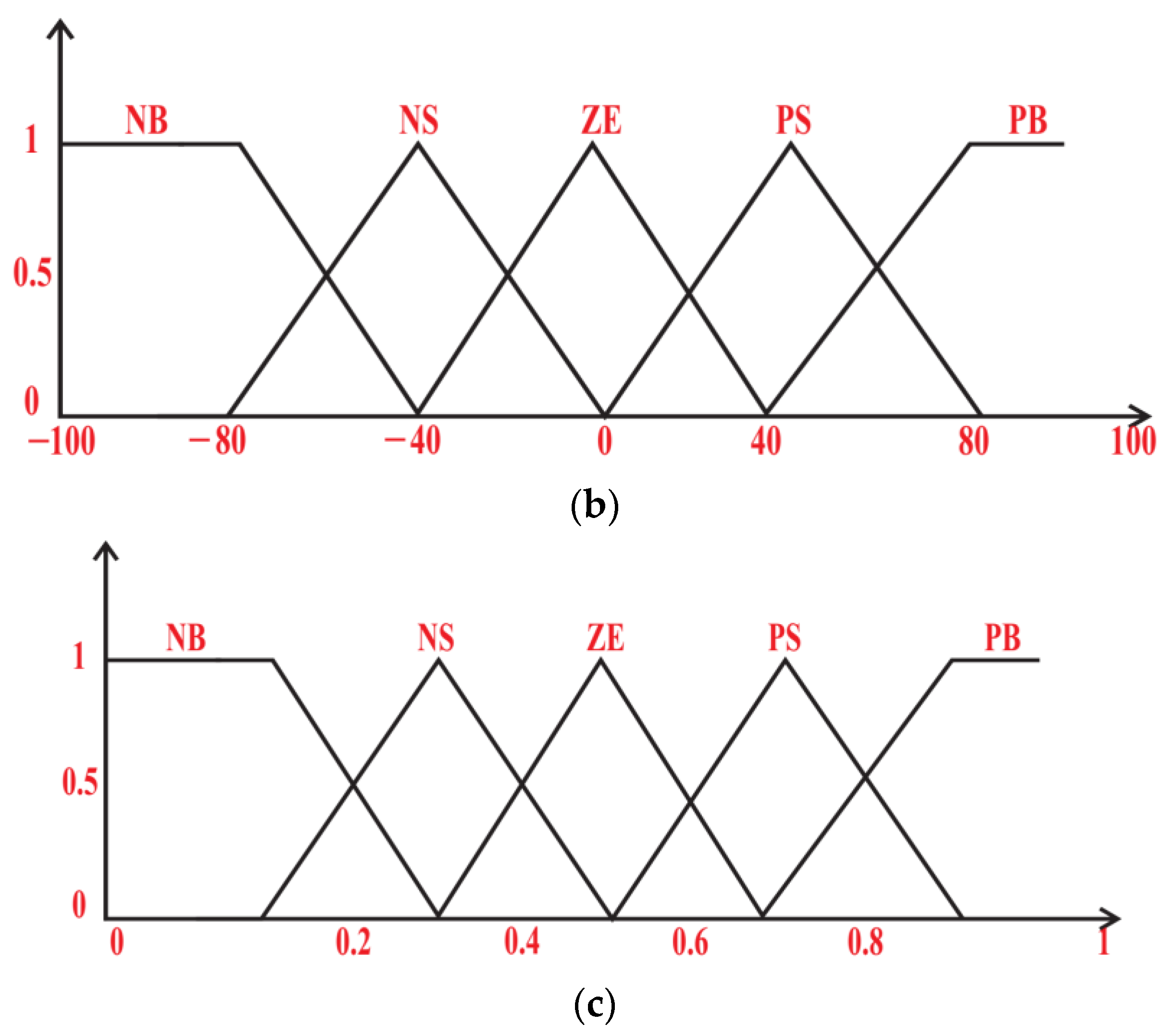1. Introduction
The operating principles of WECSs, which transform the kinetic energy of the wind into rotational mechanical energy to drive the generator, are very similar despite the fact that WECSs come in a variety of shapes and designs. The structure diagram of a WECS system is seen in
Figure 1 and includes the following: the wind turbine (WT) blade (the part that transforms the wind kinetic energy into the rotor rotational mechanical energy), the gearbox (or direct drive), generators, rectifiers, inverters, power output filters, transformers, loads, and a central controller that monitors the WT system.
The link between WECS and wind speed is shown in
Figure 2. It is usually divided into four different working zones. When the wind speed is less than 3 m/s in Zone 1, the wind turbine is locked and, therefore, not operational. When there is a stronger wind than 3 m/s but less than 12 m/s, the turbine operates regularly in Zone 2. When the wind speed in Zone 3 reaches the recommended level of 12 to 15 m/s, the wind turbine maximizes power at this wind speed; when the speed exceeds 15 m/s in Zone 4, the wind turbine causes damage to the WECS.
WECS works regularly and for a long time in Zone 2 of
Figure 2 because Zone 3 is the ideal working region for WECS to work and extract maximum power due to the uncertain wind speed [
1], which must always be ensured that the proposed solution uses modern algorithms to maximum power point tracking (MPPT) to each wind speed.
A separate maximum power point will be generated for each wind speed level.
Figure 3 shows the MPP corresponding to each wind speed, from which the MPP curve of WECS is formed.
The main purpose of MPPT algorithms is to monitor and maximize power extraction from the WECS. As previously stated,
Figure 2 shows the WECS long-term stable working area from
Vcut-in to
Vcut-out, with the rated power in the
Vrate position. If WECS works above its rated speed, its long life and mechanical strength are reduced. When WECS operates in the
Vrate region, this is the most efficient working area for the generator power. However, the regular working area of WECS is generally in Zone 2 of
Figure 2, where parameters such as speed wind, torque, voltage, current, pulse period, optimal power, etc., have to be considered and estimated in generating dependent functions that take into account the constraints in optimization problems. This is one of the most challenging problems for using modern algorithms to extract the MPP of the PMSG generator for WECS. In addition to helping the WECS system maximize its output at varying wind speeds, MPPT algorithms may also give users more control over the system’s ability to generate electricity steadily, which is essential whether it is connected to the grid or delivered directly to households with high demand [
2].
MPPT algorithms for this study have implemented an overview of modern MPPT algorithms applied to PMSG in WECS with MPP methods based on speed convergence, efficiency, self-training, complexity, and measurement of wind parameters in WECS are commonly divided into three main categories: conventional MPPT methods, intelligent MPPT methods, and hybrid MPPT methods. Each method mentioned above has numerous subdivisions, which are explored in the following section.
The generator is essential in the WECS. Compared to other generators currently in use, the PMSG generator has more advantages, such as being brushless, no need for external excitation sources, easy maintenance, high output power efficiency, and the ability to generate large power, although the cost is a bit expensive. It shows the wide application of WECS.
The complete paper’s structure is provided below: the mathematics model of WECS is presented in
Section 2, the classification of modern MPPT algorithms for WECS is explained in
Section 3,
Section 4 is the discussion,
Section 5 is the conclusion, and
Section 6 is the trends and development in the future.
2. Mathematics Model of WECS
The process of converting wind velocity into a rotating function drives the generator via the WT wing. Equation (1) describes a turbine’s mechanical power:
In which Cp(λ, β) is the WT power coefficient; ρ is the density of the air (normally ρ = 1.225 kg/m3); β is the angle of pitch; A is the space that the rotor blades sweep (in m2); and ν is the wind velocity (m/s).
The WT’s mechanical power coefficient
Cp(
λ, β), known as the proportion of wind power accessible to mechanical power at the turbine shaft, explains how effectively a wind turbine can produce power.
Cp(
λ, β) is represented using a generic equation. This equation [
3] can be found by using the shaping turbine properties:
with
.
In which
Cp is a nonlinear function of both the tip speed ratio and the blade pitch angle, and
λ is defined as the ratio of the turbine tip speed
ωm*R to the wind speed
ν. Therefore,
λ is defined as [
4]:
In which ωm is the angular velocity, and R is the turbine blade radius. If the pitch angle is constant, Cp is only a nonlinear function of the tip–speed ratio (TSR), λ. There is a relationship between TSR and angular velocity. As a result, in Equation (3), given ν, at a particular ωm, the power is most significant, the rotational speed that is ideal, ωopt. This speed is equivalent to the optimum TSR, λopt. The TSR remains constant across all MPPs. The wind turbine should continuously work at MPP at speeds lower than the rated wind velocity to maximize power at variable wind speeds.
3. Classification of Modern MPPT Algorithms for WECS
Based on current research and application results, the algorithm can temporarily be classified as conventional, intelligent, and hybrid in
Figure 4. Conventional MPPT technologies are divided into two categories based on their power control methods: indirect power control (IPC) and direct power control (DPC). The TSR algorithm is one of three in the group of IPC algorithms [
5]. This method needs a wind velocity sensor to change the gear ratio and alter the speed of the turbine rotor to drive the generator. However, wind turbulence can cause the wind speed sensor to be inaccurate, leading to deviation when extracting the maximum power of WECS [
6]. The additional two MPPT methods are power signal feedback algorithms (PSF) [
5,
6] and the torque optimization algorithm (OT). There is no need for an aerometer, but the manufacturer must provide exact wind speed parameters [
7,
8,
9].
MPPT techniques such as perturbation and observation (P&O), incremental conductance (INC), and optimal relationship-based algorithms are classified as DPC algorithms. In order to measure wind speed or torque, these algorithms do not utilize mechanical sensors; therefore, the maximum power point (MPP) is calculated using previous analysis results to determine the maximum value advantage when WECS operates. The hill climbing search algorithm (HCS), similar to P&O methods, is popular due to its adaptability in the control process, but adjusting the search step width, direction of displacement, and MPP convergence are all strongly dependent on wind speed [
10]. This process is improved by changing the fixed search step width or adaptive search step, and there are some additional modifications in the P&O algorithm that improve the problem of MPPs tracking and algorithm convergence rate [
11,
12,
13]. Regarding the algorithm power factor, the INC algorithm extracts more maximum power than the P&O algorithm [
14,
15]. Additionally, some additional measures added to the modified INC algorithm led to faster MPP tracking and convergence than the original [
16,
17]. Because the ORB algorithm [
18,
19] must use the available information provided by the factory, there are many difficulties in the calculation process and many changes to suit when implementing this algorithm [
7,
20].
The following algorithms are adaptive MPPT algorithms [
21,
22], as well as intelligent MPPT algorithms [
23,
24,
25] have significant advantages over conventional algorithms, including the ability to accurately MPPT, fast convergence speed, and stability at the MPP. Furthermore, in addition to the algorithms above, hybrid algorithms combine the best features of various algorithms, such as the combination of conventional algorithms, the combination of traditional algorithms and conventional algorithms [
26], or between intelligent algorithms to create a new MPPT combination to achieve outstanding WECS features.
3.1. Conventional MPPT Algorithms
3.1.1. Conventional MPPT Algorithms Based on IPC
IPC algorithms extract maximum power for the WECS by using signals from mechanical sensors such as wind or torque or characteristics that indicate usage on non-electrical signals. TSR, OT, and PSF algorithms are examples of these algorithms. The following characteristics of this group of algorithms are discussed in detail:
The TSR algorithm for WECS maximum power extraction process is
ωm, and an aerometer generates a reference speed
ωref. These two parameters are sent to the MSC to generate the best power for WECS [
21,
22]. The TSR algorithm has benefits such as a simple algorithm scheme and fast signal processing due to the low input data, demonstrating that the TSR algorithm plays an optimal rotor speed conversion role under continuous environmental conditions [
23,
24]. There are two methods for processing the received wind speed signal: the first is to collect the signal directly from the wind sensor, and the second is to predict the wind speed level using achieved output power [
25]. The sensor signals of wind speed installed on the turbine are fed to the input signal processor with a −10% accuracy rate in the first method [
26]. One of these algorithms’ limitations is that installing many wind speed sensors raises the cost and initial investment costs. The wind speed estimation in the second approach is performed by experiment from the manufacturer or the researchers, with this method providing the exact wind speed corresponding to different times of WECS, creating relatively accurate value, faster processing time, and simpler and more efficient [
26]. The model of the TSR algorithm, as shown in
Figure 5, makes creating the TSR algorithm easier.
The OT algorithm is shown in
Figure 6. The algorithm implementation entails adjusting the generator torque using a torque curve corresponding to variable wind speed [
22,
25]. The optimal constant
Kopt decides the turbine efficiency, and the algorithm always emphasizes the need for empirical system values [
27,
28]. The optimal torque value
is the sum of the two input signals from the turbine rotor torque sensor and the
Kopt optimization factor. This optimum torque value is combined with the manufacturer torque value
Tem for adjustment during maximum power point tracking. The OT algorithm benefits include higher performance, ease of implementation, and better MPPT ability. However, the common problems of this algorithm greatly affect weather conditions and require WECS parameters from the provider [
29,
30].
PSF algorithm was built through experiments or simulations for each type of wind turbine [
31]. There is also a variation in this method that does not require a sensor of wind speed, in which the calculated
value is related to the rectifier DC voltage with the current wind velocity. Calculating the reference wind speed
ωref is performed using the power curve and predicted wind power [
32]. Wind speed and torque speed are used as input signals, and the controller corrects the difference between the optimal and actual power of the system [
33].
Figure 7 explains the PSF algorithm diagram. This technique is comparable to the OT algorithm, which frequently has high inertia when wind speed is low but reasonable cost and quick processing speed.
The MPPT algorithm’s properties are based on the IPC approach summarized in
Table 1.
Table 2 lists some references for the MPPT algorithm, which is based on the IPC method.
3.1.2. Conventional MPPT Algorithms Based on DPC
This section mentions P&O algorithms, INC algorithms, and ORB algorithms.
This algorithm monitors variables such as the rectifier output voltage DC or the rotor speed and observes these variables’ impact on the output power of WECS. The P&O algorithm resolves the collected output power by generating power from the
P—ω graph. This technique has many advantages, such as simplicity and quick response, because there is no need to use information from the supplier system, even without using a speed sensor [
35,
36]. The P&O algorithm working process is simple in
Figure 8. The controller shifts the working point to the left side of the MPP while it is to the right of the MPP, and vice versa, until the working point is linked to the MPP. WECS then catch the greatest power possible at that moment.
This algorithm is very popular because of its simplicity and ease of use. The most significant limitation of this algorithm is that it calculates the step value when searching for the MPP. If the search step is significant, it fluctuates around the MPP. The convergence time is better when the search step is small, but the response time is slower. Another problem with this algorithm is that it is easy to lose MPPT when the wind suddenly changes speed.
Figure 9 shows the continuous search and the quick shift in the search step at varying wind speeds.
Figure 10 shows the algorithm’s two input variables, turbine rotor speed and mechanical power, as the P&O algorithm processes them to form the reference speed value
ωref, which is then combined with the original turbine rotor speed value to MPPT of the WECS.
After the rectifier, the two DC voltage and current parameters monitor the system output power.
Figure 11 shows how the INC algorithm processing is divided into search positions, including the MPP left side, at the MPP, and at the MPP right side. Two values of current
I(
k) and voltage
V(
k) measurements are used as sample values, which are then compared to the previous value, resulting in errors Δ
U and Δ
I, which are used to MPPT and identify the direction of turbulence.
If the value of V(k) is too small, the signal dP/dV is determined by dI(k).
If the value of
V(
k) is large enough, then the
dP/dV signal is calculated according to the following equation:
If dP/dV > 0, the pulse period increases; if dP/dV < 0, the pulse period decreases; and if dP/dV = 0, the output power value is at MPP.
The information and sensors of the WECS are eliminated in this method, resulting in increased reliability and performance in
Figure 12 [
37].
The implementation of this method is based on the relationship between the WECS parameters [
38,
39]. The voltage, current of the DC rectifier, and power are input signals in the simple implementation method. However, some studies address the optimal relationship between turbine rotor power and wind speed [
40], power with electromagnetic torque [
7,
41], power with voltage DC [
42], and the relationship between voltage and current DC [
43]. Compared to other conventional algorithms, it has more advantages, such as a simple working principle, fast response speed, and reasonable cost because it does not require sensors and system information. As a result, it can be commercialized for application in WECS. However, this is also a limitation due to the algorithm’s high memory requirements [
44,
45,
46].
Figure 13 describes the ORB algorithm diagram.
The MPPT algorithm’s properties are based on the DPC summarized in
Table 3.
Table 4 lists references for the MPPT algorithm, which is based on the DPC method.
3.1.3. WECS Conventional Modification MPPT Algorithms
There are also limitations in conventional algorithms, such as oscillation around MPP, high memory requirements, or convergence speed. Additionally, the algorithms are still commonly utilized in WECS because of their straightforward design and inexpensive cost. However, making decisions between performance and convergence rate necessitates modifying the MPPT algorithms to improve WECS performance. This section discusses modification algorithms, including the modified perturb and observation algorithm (MPO), the modified incremental conductance algorithm (MINC), the modified torque optimization algorithm (MOT), and the modified power signal feedback (MPSF).
With its straightforward design and simple implementation, the CPO algorithm is an excellent option for the MPPT algorithm in the WECS system. Due to the limitations discussed in the previous section, CPO becomes MPO to enhance MPPT performance and capability. Therefore using fixed search steps causes oscillations around the MPP, delaying the convergence time and decreasing efficiency. Modifying variables and changing the search steps in the MPO has improved WECS performance [
38,
49]. Based on the size of the search step, the MPO variables may be categorized into the following types in
Figure 14:
Fixed step: The step width will not change during MPPT (
Figure 14a);
Variable step: The width of the step will change to the tracking zone (
Figure 14b);
Adaptive step: The step width will automatically detect to track MPP (
Figure 14c);
Combined step: Combination of two steps. The initial step can be used for the appropriate width, and then the search method will be used near the MPP (
Figure 14d).
Additionally, MPO algorithms can be classified based on their aim functions, optimization techniques, power curve, or hybrid algorithm. The power curve divisions are that each region has an independent search step, there is a reasonable search step for each wind speed level to ensure the convergence time, the way the hybrid technique works is overcome quickly through the low power positions, and when it gradually reaches the MPP, it conducts detection to track the point MPP needs to be achieved accurately. Each method determines the width of the MPO search step based on relationships, ratios, or power curves. By subdividing the power curve into small areas corresponding to the characteristics of the input variable, such as wind speed, the torque determines the MPP search step width, then sums all small curves into a complete curve. The complexity associated with curve synthesis is reduced by using ratio synthesis involving the measurement of output power, rotor speed, or both.
The optimal power estimation for the synthesized ratio is performed. The usual relationships are provided by observing control variables such as current, voltage, output power, and perturbation step. The CPO algorithm can be optimized by combining PID and some intelligent algorithms to improve the MPO algorithm working efficiency [
50].
The torque
T in the COT is given as follows:
Modifications to this method are mentioned in [
51,
52], where torque is expressed as increasing and decreasing via Formula (6). While
G is the gain to adjust
T,
ω is the rotor speed, and
Tm is the mechanical torque the wind turbine receives.
The primary goal of this modification is to help in faster tracking in order to generate a large moment of inertia that limits torque when the wind speed changes suddenly. This enhances and increases the MPPT process.
The main goal of using the modified MPSF method is to prevent PMSG from shutting down unexpectedly, which can only be achieved by adding up the calculated power by a fixed value [
42,
52]. In addition, the frequency of stator integral is fed into WECS to increase its sensitivity to rapid changes in wind speed. This improved strategy’s major objective is to eliminate the undesired by keeping an eye on the control variables and raising the maximum power point.
Table 5 lists some of the studies on modified MPPT algorithms.
3.2. Intelligent MPPT Algorithms
WECS is a complex control system for operation control, which is difficult to describe in the form of mathematical functions. Methods based on conventional or modified algorithms used mathematical models to create appropriate control rules to maximize the WT output power combination. However, due to the changing characteristics of WECS, it is also challenging to see the efficiency of the control process in certain control systems. As a result, establishing an exact mathematical model for the wind turbine system is difficult [
53,
54]. The description of intelligent algorithms such as neural networks (NNs), fuzzy logic controllers (FLCs), and a series of algorithms based on computational software has overcome limitations that conventional algorithms could not effectively solve, such as convergence speed, oscillations around the MPP, and the effects of rapid changes in wind speed. There are many MPPT techniques in the form of optimization algorithms, in which methods such as particle swarm optimization (PSO) and swarm optimization versions are frequently mentioned, such as grey wolf optimization algorithm (GWO), bird swarm algorithm (BDSA), genetic algorithms (GA), and teaching–learning-based optimization (TLBO) [
55], etc., contributed to the process of making WECS more efficient by resolving the MPPT problem. Combining intelligent and conventional MPPT methods can sometimes provide more options for the MPPT problem, overcoming the limitations that conventional MPPT methods face.
3.2.1. Fuzzy Logic Control MPPT Algorithm (FLC)
Conventional or modified algorithms are unable to effectively address the actual issues when the wind is continually changing because the MPP oscillates, which causes variations in the WECS’ output power. As a result, the FLC algorithm has effectively solved the problem of oscillation around the MPP caused by environmental factors [
56].
The FLC algorithm always has the advantage that the variables can change quickly, corresponding to the dynamic model of WECS. The FLC algorithm tracks around actual existing values of the system, eliminating the mathematical models. Overall, the algorithm solves the problem of environmental conditions’ impact quickly, and the output power of WECS is outstanding. On the other hand, the FLC algorithm is heavily reliant on the ability to establish the rules of the variables through in-depth research on WECS to choose the best rules and membership functions. Furthermore, a factor that needs much discussion in this regard is the large memory requirement [
57]. Many improved and combined versions are also based on the FLC algorithm [
58,
59].
Figure 15 shows a schematic of the FLC algorithm.
The fuzzy set of variables contains linguistic variables representing each input/output variable utilized in the controller design. For example, the symbols for wind speed error “
e”, wind speed derivative “Δ
e”, and change in electromagnetic torque “
T”. The properties of the triangular membership function shown in
Figure 16 are negative big (N-B), negative small (N-S), zero (Z-E), positive big (P-B), and positive small (P-S). Scale factors improve the ability of the dynamic model and controller converter to follow the input and output variables.
After the fuzzing of the member variables, the following step is based on the control rule defined by the set of IF–THEN rules shown in
Table 6.
For example, if wind speed error “e” and wind speed derivative “Δe” are both NB, then the obtained value of electromagnetic moment derivative “Te” is also N-B.
Based on the control rule, the output language variables must be converted into specific values for the electromagnetic torque control process. This technique provides the control goal by using the two values of electromagnetic torque and the derivative of electromagnetic torque [
56].
According to the diagram in
Figure 15, signals such as rotor angular velocity
ωm, mechanical torque
Tm, generator current
Ig, and generator voltage
Ug are considered input variables, which are processed by member functions according to a specific rule, then defuzzified to generate the mechanical torque deviation signal Δ
Tm at the FLC controller and this signal is combined with the mechanical torque
Tm to provide a control signal for the machine side controller (MSC) to MPPT. This algorithm is based on power forecasting and does not require sensor signals from wind velocity.
3.2.2. Artificial Neural Networks (ANN) MPPT Algorithm
Compared to the controller using the FLC, which requires parameters of the WT’s system, the ANN algorithm is established and set up to simulate the operation of human neurons, so the structure is more complex. This algorithm does not necessitate knowledge of WECS parameters, but the results show that MPPT ability and MPP convergence speed performed better than FLC [
60]. Non-analytical, nonlinear, unstable, and random problems, as well as a lack of programming knowledge, can all be solved using ANN algorithms. A wide range of problems, particularly, can be solved without programming or other intervention in its programs [
61]. According to theory, there are many different versions of ANN, but in ANN structure, there are three layers: the first layer is input, then the hidden layer, and the last layer is output. The number of nodes to apply to the ANN algorithm is up to the user, and this choice is not mandatory for everyone, as input variable values such as rated voltage, wind speed, output torque, etc., are used. In order to control the power electronic controller, output values provide reference variables such as reference power and reference rotor speed. The layers’ node weights decide which working point will coincide with the MPP of WECS.
ANN has many benefits for wind speed and power predictability, such as self-learning–teaching, low error, simplicity, and high-efficiency predictability, which allows rapid development in applications that use the ANN algorithm for WECS [
55]. There are many different classes and versions of the ANN algorithm in the classification of branches, such as back propagation neural network (BPNN), convolutional neural network (CNN), wavelet neural network (WNN), recurrent neural network (RNN), etc. However, all of these algorithms are based on the three-layer implementation principle.
The ANN algorithm input signal is trained and fed to the system for a specific input and output direction. Training previously processed and memorized signals will help reduce signal processing response time, resulting in rapid stabilization around the MPP point even at high wind speeds changing rapidly. This method enhances the trade-off between output power and reaction time [
62].
Cell nodes are interconnected and influence one another. Each cell node has its own data, which are continuously updated, and the output of these data is sent to the other neuron. The activation node or value node is each neuron output. The ANN algorithm for MPPT applies to both IPC and DPC types by predicting the wind speed and power of the WECS.
3.2.3. Space Vector Module (SVM) MPPT Algorithm
On small samples, the SVM algorithm aims to simplify the prediction structure. As a result, prediction results are typically more accurate than the ANN algorithm. Furthermore, this algorithm can be applied to MPPT in both DPC and IPC methods.
The input signal for the SVM controller is taken from the electromagnetic torque
Te and the voltage of the generator, as shown in
Figure 17. Additionally, other controllers, such as the gain schedule algorithm (GS), the PSO algorithm, and some other algorithms, can be combined with the SVM algorithm to improve MPPT capability for WECS, as described in [
63] for the GS algorithm combining with pulse period controllers
Ds and generator rotation frequency
f(
ωs). A proposal in [
64] for a generator-side five-stage controller using an SVM algorithm can work without a gearbox in low wind speed, allowing control of active and reactive power to the grid via a DPC with an SVM algorithm.
3.2.4. Swarm Optimization Algorithm (SOA)
SOA are inspired by nature or a particular phenomenon, such as the genetic algorithm (GA) [
65], differential evolution theory (DE) [
66], particle swarm optimization (PSO) [
67], ant colony optimization (ACO) [
68,
69] and brainstorm optimization (BSO) [
70]. In order to determine the optimal location within the swarm and the best ways to control their behavior across a very large number of contacts, these algorithms mimic natural swarm behavior. Although each individual has unique abilities, it is possible to display behavior in a large flock by encouraging cooperation and mutuality among individuals. As a result, SOAs can use instances discovery and collaboration capabilities to optimize solutions during implementation as shown in
Figure 18.
3.2.5. Sensorless MPPT Algorithm
The sensorless method eliminates mechanical sensors as well as WECS parameters. Researchers have proposed sensorless MPPT algorithms to accurately recognize wind speed via power converter input values such as
Pin,
Uin, and
Iin, as shown in
Figure 19.
In the characteristic diagram showing the dependent relationship in
Figure 20, the
Pin input power and tip speed ratio
λ forms relationships between input power, voltage, and current without using mechanical sensors, speed wind, or generator rotor speed [
71].
This proposed method uses only two electrical parameters, including voltage and current. It has eliminated mechanical sensors and system information, helping it to limit the problems encountered in methods that use sensors. This method, combined with intelligent algorithms such as FLC [
72] or ANN [
73], has shown high performance and faster convergence time when MPPT [
74]. Outstanding characteristics of the MPPT intelligent algorithms have been mentioned in
Table 7.
Table 8 lists some author studies on intelligent MPPT algorithms for WECS.
3.3. Hybrid MPPT Algorithms
As mentioned, each algorithm has different advantages and disadvantages. Two or more algorithms used together in one MPPT controller are called hybrid algorithms. Hybrid algorithms increase the advantages of each algorithm and reduce the disadvantages of combining processing to maximize the capacity of WECS. A series of studies have shown outstanding results when combining two or more MPP algorithms. This combination was born based on the combination of traditional methods, traditional methods with intelligent algorithms, or between intelligent algorithms.
3.3.1. Hybrid Conventional MPPT Algorithms
Because of the CPO algorithm’s simplicity and ease of use, many researchers have used hybridization algorithms in WECS systems to track MPP for renewable energy sources. The disadvantage of the CPO algorithm is that it oscillates when tracking MPP. Knowing how to combine algorithms will also solve the trade-off between speed and performance and the change in direction under rapid wind speed. The optimal torque controller (OTC) is used in combination with either the HCS method or the CPO method. This algorithm combination problem solves two problems: the first is choosing between speed and performance, and the second is heading in the wrong direction when the wind speed changes continuously [
78]. The P&O adaptive algorithm, when combined with the ORB algorithm, operates in two modes and has better MPPT ability [
79].
Another type of hybrid algorithm for combining the CPO algorithm with the OT, TSR, and PSF algorithms to overcome the problems that the CPO algorithm faced when MPPT, especially the problem of tracking in the wrong direction when wind speed sudden changes have been mentioned in research [
10,
80,
81,
82]. The combination of two algorithms, CPO and PSF, is proposed in [
83] to have two modes of operation: one is called the search mode, which uses a modified HCS algorithm to search for the MPP point under wind change, and the other is called the application mode, which tracks the MPPT point and limits fluctuations at the MPP.
3.3.2. Hybrid Conventional Algorithms with Intelligent Algorithms
A hybrid form used in the MPPT tracking technique is the combination of the intelligent algorithm with a conventional algorithm, as demonstrated in the hybrid between the FLC algorithm and CPO algorithm, creating better tracking MPP in both dynamic and static modes. As a result, MPP tracking performs better than conventional MPPT methods [
84]. Moreover, this method has been implemented and applied in practice for WECS under changing wind speed conditions. Additionally, MPPT is built on the ANN algorithm in conjunction with the P&O method previously discussed [
85], the advantages of which include the removal of information about the value of the gear ratio and the power coefficient C
p as well as the more accurate results. The study [
86] proposed a method to combine the PSO swarm optimization algorithm and the ORB optimal relationship-based algorithm, with two operating modes called PSO mode and ORB mode in this algorithm. The peak for each wind speed will be located via PSO mode, and the current and voltage values at each MPP are calculated to look up the unknown ORB algorithm coefficient.
3.3.3. Hybrid Intelligent Algorithms
Depending on the signal processing features used in the combining process, the intelligent hybrid MPPT algorithms may be classified as data-preprocessing-based techniques, parameter-optimization-based methods, data-mining-based methods, and deep-machine-learning-based approaches. The main algorithms, such as FLC, SOA, or SVM, play a central role in the combined algorithms in various versions. These combined algorithms, which all perform better than the independent MPPT algorithms, proposed an algorithm combining three MPPT methods with PSO to predict wind energy in the short term. This study demonstrated that its relative error is deficient, and the prediction process is very high. In the short term, the proposed model could be applied to predict wind energy [
87], which shows that, compared to predicting MPP, PI predicting is a relatively effective method for estimating the random nature of wind energy.
However, this method includes some complex assumptions and calculations, and it proposes an optimal solution that combines the multi-objective artificial bee. In order to improve wind energy prediction, researchers used a colony (MOABC) and multi-objective evolutionary knowledge (EKMOABC). Numerous intelligent algorithm combinations are based on wind power and wind speed prediction techniques to ensure maximum power tracking of WECS systems and improve MPPT tracking ability under wind speed control. Sudden changes influence the WECS in environmental conditions.
4. Discussion
Capturing and converting the most power available from the WECS system is the primary objective of MPPT algorithms. Various algorithms are listed, resulting in a challenge in deciding which method is most suitable. The comparisons show that IPC algorithms are far more straightforward and produce quick results. However, the majority of the sensors used for IPC are mechanical sensors, which operate more quickly than sensors that measure from a power source and can easily show mistakes while operating for an extended period of time, causing WECS’s MPPT to become stuck.
On the other hand, DPC algorithms do not need sensors, are affordable, and are easy to use. However, if there is an enormous sudden change in wind speed, DPC algorithms do not extract power well. The CPO algorithm is widely used in conventional algorithms because it has many advantages over other conventional algorithms, such as simplicity, low cost, and ease of implementation. However, the disadvantages of conventional algorithms are oscillation around the MPP and a strong disturbance when the wind speed changes rapidly.
When compared to conventional algorithms, MPPT intelligent algorithms such as FLC; different versions of SOA such as PSO, GWO or ANN; and SVM have outstanding internal characteristics such as stability and low fluctuation around MPP, high speed, high convergence, and good memory of MPP positions at various wind velocities when the wind speed changes continuously and does not change power tracking direction. These advantages are also maximized when intelligent algorithms are combined to complement and support one another advantages while limiting flaws in the process of tracking MPPT scores under the influence of MPPT environmental circumstances. However, there are limitations to intelligent methods, such as high complexity, the need for memory to remember data, etc.
In summary, between the conventional and intelligent MPPT algorithms through research and analysis results, the MPPT process uses intelligent algorithms for higher output maximum power tracking results and do not oscillate at the MPP better under the sudden change in various wind speed.
5. Conclusions
The MPPT method is the key to enhancing MPPT from the WECS system. This review has covered many MPPT algorithms. The overview results of MPPT methods show that each algorithm’s advantages and limitations must be determined to choose the best solution to improve output power. This review provides an exceptionally detailed and comprehensive comparison of previous and current MPPT algorithms. The comparison method is established on the IPC and DPC techniques, followed by intelligent and hybrid algorithms. Based on the comparison results, the hybridization algorithms are often more efficient. Hybrid MPPT algorithms take the best features of each individual MPPT algorithm and eliminate their limitations to provide the best results when tracking MPP in changing weather conditions. There are many ways to classify algorithms, such as the MPPT algorithm using DPC or IPC controller, power prediction and wind speed prediction method, sensor or without sensor. However, there are numerous approaches to the MPPT problems, but the current and future general trend for wind power systems is that controllers based on intelligent algorithms will be deployed and widely used in reality.
6. Trends and Development in the Future
Based on the overview of the types of MPPT algorithms used for WECS, there will be an increasing demand for renewable energy in the future; therefore, in order for MPPT from the WECS to fully address the negative effects of environmental impact, optimum solutions must be found. Therefore, intelligent algorithms will be widely applied in wind power systems in particular and other renewable energy systems in general. With the benefits that have been studied and analyzed from MPPT algorithms such as FLC using a series of previously received information, it is simple to control the dynamic models of WCES or the ANN algorithm with slight fluctuation, small around the MPP. However, the signal processing is relatively fast, the MPP convergence is high, the dynamic process can be predicted well, and the parameters are continuously updated to make the power extraction more stable.
Furthermore, algorithms based on SVMs or SOAs with different versions, such as PSO, GWO, and Marine Predator Algorithm (MPA) [
88], etc., show an excellent approach to predicting power and wind velocity. Therefore, different intelligent algorithm versions will be added and combined to create MPPT algorithms with high speed and processing ability in the presence of external factors affecting WECS.
